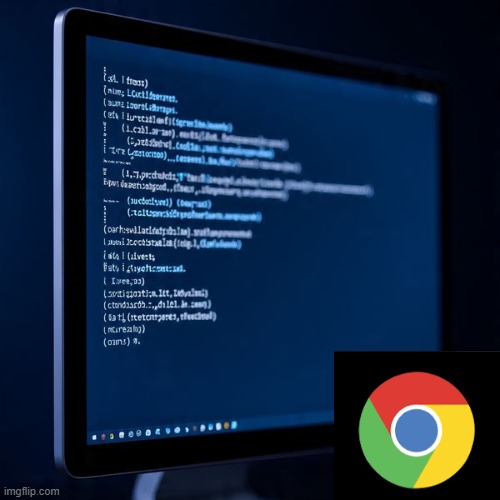In June 2025, a critical Chrome zero-day exploit tracked as CVE-2025-6554was discovered. This new Chrome vulnerability affects the browser’s JavaScript engine and has already been weaponized by attackers in the wild.
Google has since released a patch, but the nature of this Chrome exploit makes it urgent for users and organizations to understand the threat and take action.
Check Your mobile for vulnerabilities, Book a Pentest session
Table of Contents
What Is the Chrome Exploit CVE-2025-6554?
CVE-2025-6554 is a type confusion vulnerability in V8, the JavaScript and WebAssembly engine used by the Chrome browser. Type confusion flaws occur when the browser incorrectly handles variables, leading to unexpected behaviors, such as allowing malicious actors to read or write arbitrary memory or even execute remote code.
According to the National Vulnerability Database (NVD), the vulnerability allows attackers to craft a malicious HTML page that, when visited by a victim using an unpatched version of Chrome, can trigger arbitrary read/write capabilities in memory. In simpler terms, a hacker could potentially take control of your browser, and possibly your system just by getting you to click a link.
Why This Chrome Vulnerability Is Dangerous
What makes CVE-2025-6554 particularly dangerous is that it is a zero-day exploit. This means attackers were already using the vulnerability before Google became aware of it and could issue a fix.
Here are the key risks of this Chrome zero-day exploit:
Remote Code Execution (RCE): The attacker can potentially run malicious code on your system without your consent.
Drive-by Attacks: Simply visiting a compromised or malicious website could trigger the exploit.
High-Value Targeting: Discovered by Google’s Threat Analysis Group (TAG), this Chrome vulnerability is believed to have been used in highly targeted attacks , possibly by nation-state actors or surveillance groups.
Discovery and Response Timeline
Reported: June 25, 2025
Discovered by: Clément Lecigne of Google’s TAG team
Mitigated: June 26, 2025 — via a configuration change rolled out across all platforms
Fixed in Version: Chrome 138.0.7204.96 (Stable Channel)
Google acted quickly by pushing out an emergency update to mitigate the issue, but many users may still be running older versions of Chrome and remain vulnerable to this Chrome exploit.
A Technical Glimpse: What Is Type Confusion?
Type confusion occurs when a program allocates memory for one type of object but mistakenly accesses it as a different type. This mismatch can lead to memory corruption, bypassing of security mechanisms, and ultimately arbitrary code execution.
In the case of CVE-2025-6554, the flaw is in the V8 engine’s handling of JavaScript and WebAssembly. When triggered correctly via a malicious HTML file, it allows the attacker to gain memory access privileges they should not have, opening the door to full browser or even system compromise.
Who Is at Risk?
While the exploit has been seen in targeted attacks, the underlying Chrome vulnerability is present in all unpatched versions of Chrome prior to 138.0.7204.96. This includes:
Individual users
Enterprises and corporate networks
Journalists, activists, or government workers handling sensitive data
Any Chrome-based browsers that haven’t yet applied the update
If you or your organization rely heavily on browser-based work, this is not a vulnerability to ignore.
How to Check If You're Vulnerable
To check your current Chrome version:
Open Chrome.
Go to Menu → Help → About Google Chrome.
Chrome will automatically check for updates and prompt a restart if an update is available.
Ensure you’re running version 138.0.7204.96 or later. If not, update immediately.
How to Protect Yourself from the Chrome Exploit
Here are some steps you can take to mitigate your exposure to this Chrome vulnerability:
1. Update Chrome Immediately
The first and most important step is to update your Chrome browser. Google has already released a fix for CVE-2025-6554, but updates are only effective if users apply them.
2. Enable Auto-Updates
Keep auto-updates turned on to receive future security patches promptly.
3. Use Browser Sandboxing and Security Tools
Chrome has built-in sandboxing, but you can further secure your browsing with reputable browser extensions and endpoint protection.
4. Avoid Unknown Links
Until you’re fully patched, avoid clicking on links from unknown sources. Even seemingly harmless HTML pages can carry payloads that trigger this exploit.
5. Monitor for Unusual Activity
Keep an eye on system behavior, especially if you’re in a high-risk role. Sudden slowdowns, browser crashes, or suspicious processes could be a sign of compromise.
Final Thoughts
The emergence of the Chrome zero-day exploit CVE-2025-6554 is a stark reminder of how quickly browser vulnerabilities can be discovered and abused, even by sophisticated threat actors. While Google’s rapid response is commendable, anyone who hasn’t updated is still at risk.
Whether you’re an average user or part of a security-conscious organization, patching your browser is your first and best defense. As threat actors continue to innovate, staying updated is not optional, it’s essential.
Why Businesses Trust SecureMyOrg for Comprehensive Network Security
At SecureMyOrg, we uncover and fix all possible security vulnerabilities of mobile and web, while providing solutions to mitigate risks. We are trusted by renowned companies like Yahoo, Gojek and Rippling, and with 100% client satisfaction, you’re in safe hands!







Some of the things people reach out to us for –
- Building their cybersecurity program from scratch – setting up cloud security using cost-effective tools, SIEM for alert monitoring, building policies for the company
- Vulnerability Assessment and Penetration Testing ( VAPT ) – We have certified professionals, with certifications like OSCP, CREST – CPSA & CRT, CKA and CKS
- DevSecOps consulting
- Red Teaming activity
- Regular security audits, before product release
- Full time security engineers.
Relevant Posts

What Is Penetration Testing as a Service?
Penetration testing as a service (PTaaS) lets experts simulate real attacks to uncover vulnerabilities before hackers do. This guide explains the process, benefits, and costs, helping businesses strengthen defenses with predictable, ongoing security checks.

How To Inspect Encrypted Traffic Without Breaking Privacy
Network administrators face a challenge: securing systems while respecting privacy. This guide explains how to inspect encrypted traffic without breaking privacy using metadata, anomaly detection, and machine learning ensuring visibility, compliance, and trust.

How to Audit Infrastructure as Code (IaC) for Security Vulnerabilities
Discover how to audit Infrastructure as Code (IaC) for security vulnerabilities with this practical guide. Learn to scan IaC files using tools like Checkov, fix issues like exposed resources, and integrate audits into CI/CD pipelines. Protect your cloud systems from misconfigurations and ensure compliance with clear, actionable steps.

DevSecOps Best Practices: Integrating Security Early in Your CI/CD Pipeline
This article provides a practical guide to embedding security into every stage of your CI/CD pipeline. Learn core DevSecOps best practices like SAST, DAST, dependency scanning, secrets management, and compliance automation to catch vulnerabilities early, foster a culture of shared ownership, and build a secure-by-design development process that accelerates release cycles.

5 Cloud Misconfigurations That Lead to Data Breaches
Cloud misconfigurations are one of the leading causes of data breaches, yet they’re also among the most preventable. From exposed storage buckets to weak IAM policies, attackers exploit these mistakes daily. Learn about the top 5 misconfigurations and how your organization can fix them before they lead to costly data exposure.

How Can Ethical Hacking Training Elevate Your Internal Cybersecurity?
Ethical hacking training empowers organizations to strengthen internal cybersecurity by uncovering vulnerabilities before attackers do. From mastering penetration testing to enhancing incident response, this training builds a proactive security culture. Learn how Secure My ORG’s programs can elevate your team’s skills and fortify defenses against modern threats like AI-driven attacks.

